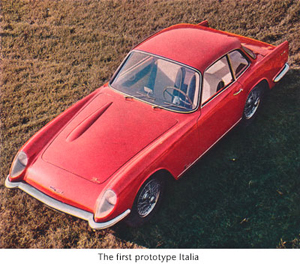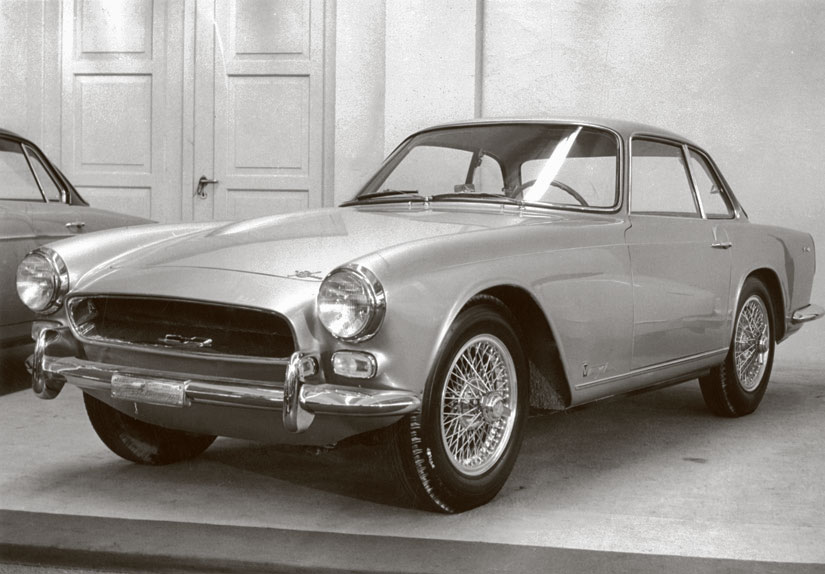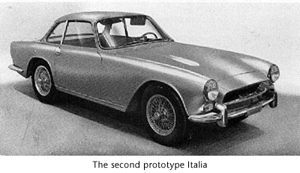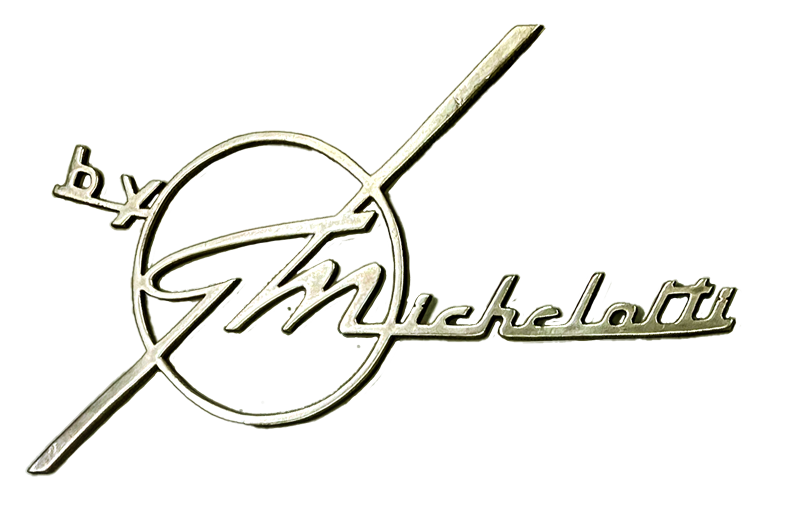I like it but . . .

There were only two prototype Italias. The first had a sloping front hood (bonnet) with glassed in headlights. It was very daring and modern for the time. Some stability issues at speed became apparent and the opening below the front bumper didn't get enough cool air to the rather small TR3 style radiator. It would be a few years yet before electric fans, modern radiators and aerodynamic studies would make a design such as this possible.
The interior for this car was done in two-tone, something not seen in any of the later cars. It also appears to have a Nardi wooden steering wheel as does the second prototype. In both this and the second car, having the Nardi wheel meant moving the turn signal switch to the transmission tunnel, just below the gear lever.
The first prototype remains unaccounted for. Dario Ruffino remembers the first prototype being converted to production Italia specification at a later date but no car has surfaced with a chassis number earlier than that used on the Second Prototype. This photo appeared in the July 1959 issue of Esquire magazine which had a feature on Italian car design. Others of the car at the 1958 Turin Auto Show appeared in Automobile Year #6 and a German-language auto magazine. A few photos are available from the Revs Institute.
Badging differs from the production cars but is similar, but not exactly the same, to that used on the show cars. The first prototype has the "by G. Michelotti" badge on the bonnet. The rare and unusual radically redesigned Triumph "Open Book" badge can be seen on the front just above the bumper (photo at left, click to see more about badges). In this instance and on the second prototype it is black on the left and red on the right, the colors being reversed in the lower half of the badge. The ne used on the show cars is much more rounded. "Triumph Italia" appears on the lower front wings near the "Vignale" badge. The rear wings sport only the "Vignale-Standard-Triumph" crossed flags.

The second prototype, which still survives, looked much more like the final design. Lots of details would be changed before the Italia as we know it arrived. The second prototype uses taillights from an Alfa Romeo (not found on the remaining production but since substituted for the rare Carello's by a few owners desperate for something that would fit). The nose appears to come further out in front of the car and the grille is set back deeper within the opening. This photo is from the June, 1959 issue of Automobile Engineer.

This car uses the rectangular Carello front parking lights. A very few owners have substituted similar rectangular lights for the missing original bullet style. Most likely because the rectangular lamps were easier to source. They may have been attempting to match the photos of this prototype which for many years were the only known photos of an Italia.

The dashboard has a silver section below the glovebox and auxillary instruments. The ignition switch is located to the right of the steering wheel in this same section next to the other switches rather than on the left side. The words, "dii prudenta" appear as a badge on the glovebox door. The ashtray is in a special housing which was also used on the "show car" Italias but not on the production ones. On the engine hood is the "by G. Michelotti" badge, "Triumph Italia" appears on the lower front wings near the "Vignale" badge.

The rear wings sport only the "Vignale-Standard-Triumph" crossed flags. The same Triumph "Open Book" badge used on the first prototype can be seen on the lower front part of the grille surround and "Triumph 2000" script appears on the boot lid. The car sports Borrani wire wheels which were possibly available as an option on the later cars but have not been seen on any surviving Italias.
This car is also the only one that is known to have had a Nardi steering wheel installed from new. It doesn't use the standard TR3 indicator and horn hub in the steering wheel. Instead, there is a timed turn signal switch mounted on the transmission tunnel behind the gear shift.
The seats, carpets, window winder handles and door pulls are different than the show cars or production. But the inner door handles look to be the same as production. Show cars have different inner door and window handles.
